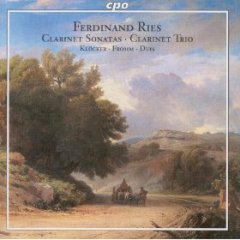Ries: Clarinet Sonatas - Clarinet Trio (2004)
Ries: Clarinet Sonatas - Clarinet Trio (2004)

1 Clarinet Trio, Op. 28: I. Allegro 8:34 2 Clarinet Trio, Op. 28: II. Scherzo: Allegro vivace 4:58 3 Clarinet Trio, Op. 28: III. Adagio 4:17 4 Clarinet Trio, Op. 28: IV. Rondo: Allegro ma non troppo 6:04 5 Clarinet Sonata, Op. 29: I. Adagio - Allegro 11:51 6 Clarinet Sonata, Op. 29: II. Adagio con moto 4:58 7 Clarinet Sonata, Op. 29: III. Adagio - Allegro non troppo 8:07 8 Clarinet Sonata in E-Flat Major, Op. 169: I. Allegro moderato 9:08 9 Clarinet Sonata in E-Flat Major, Op. 169: II. Adagio con moto 4:54 10 Clarinet Sonata in E-Flat Major, Op. 169: III. Rondo: Allegro 6:17 Dieter Klöcker – clarinet Thomas Duis – piano Armin Fromm - cello
There has been a general increase in the number of releases covering the music of Beethoven's contemporaries, and Ferdinand Ries has emerged as a strong candidate for rediscovery. Ries was a student of Beethoven and of Beethoven's teacher Albrechtsberger, and his association with Beethoven was long and close. The clarinet works featured here show him in an advantageous light. The clarinet virtuoso was a figure dating back a generation before Ries, resulting in a couple of the late Mozart masterpieces. But clarinet music was something still relatively new; the Clarinet Sonata, Op. 29, included here is thought to be only the second extant sonata for clarinet and piano, preceded by one from Vanhal.
All three of these chamber clarinet works were written between about 1808 and 1814; the high opus number of the Clarinet Sonata, Op. 169, was the result of much later publication. So all date from the height of Beethoven's fame. But it is to Ries' credit that he absorbs many aspects of Beethoven's language without sounding, in general, much like Beethoven at all. His handling of large-scale harmonic schemes that go far afield from the home key is assured and economical, and the Scherzo movement of the Clarinet Trio, Op. 28, reflects Beethoven's gruff approach to the scherzo movement. But the presence of this movement already sets the work apart from Beethoven, whose clarinet pieces were of a less ambitious cast. The painting of warm, genial tones onto a background of varied harmonies makes one think of the clarinet chamber music of Brahms; even if the parallel breaks down when one listens more closely, this disc illuminates some of the roots of Romantic chamber music. Ries likewise communicates unusual moods effectively: the Op. 169 sonata (originally written for flute but arranged for clarinet by Ries himself) was written after the composer's honeymoon and has a serene, playful streak quite unlike the humor of Beethoven's lighter pieces. Mushy sound from CPO is a problem here, but anyone interested in Beethoven and his world will find this disc worthwhile. ---James Manheim, Rovi
download: uploaded yandex 4shared mediafire solidfiles mega filecloudio nornar ziddu
Zmieniony (Wtorek, 08 Kwiecień 2014 16:41)








